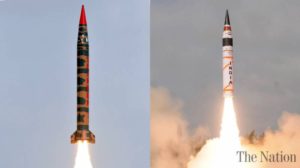
by Asma Khalid
Strategic framework of South Asia is comprised of the bipolar equation between India-Pakistan, inter-connected with Regional Security complex and other Major Powers. It is considered that in South Asia: peace and stability being with a Nuclear weapon. Nuclear arsenals are characterized as the great equalizer and ultimate tool to counter adversary’s present or future conventional strength. Pakistan’s strategists identify conventional military imbalance concerning India and find nuclear weapon a safer alternative to avoid dangerous conventional arms races to maintain security and safety at an affordable price. India should realize that by developing the nuclear weapon and compelling the Pakistan to follow suit, it has itself neutralized its conventional advantage.
Moreover, Nuclear weapons have played a significant role to revolutionize the relations among Major Powers and South Asian states. Such as positive trajectory of Indo-US Nexuses and Trump’s ‘Do More’ rhetoric for Pakistan has made the South Asia’s strategic environment more complex and unpredictable. South Asian politics are going through the profound changes since the announcement of new U.S. strategy regarding Afghanistan. Role of the South Asia in the strategic calculations of U.S. cannot be ignored due to its continued interests in West and Central Asia. Pakistan-U.S. relations have been on critical position since the President Donald Trump spoke harshly about Pakistan. Trump’s harsh rhetoric shows that Indo-U.S. Nexuses is getting deep in contemporary regional politics. Two factors are playing a compelling role to bring U.S. and India close: First is the economic rise of China and development of CPEC; secondly, Afghanistan is the main bone of contention between Pakistan-U.S. relations. U.S. believes that growing economic role of China and Russia’s resurgence in Afghanistan will affect the political influence and strategic interests of U.S. in the region. These factors are playing a key role in maintaining strong strategic ties with India and U.S.
Trump’s inclination towards India due to its’ policy of containment of China and strategic interests in Asia is making New Delhi a greater attraction for U.S. For this purpose, U.S. is vigorously assisting India in modernizing and enlarging its nuclear forces. Recent trends reveal that India is pursuing the long-term programme for conventional and nuclear force modernization to achieve strategic objectives. These objectives are manifested through the development of advanced technology and force multiplier conventional weapon systems as well as improvement in ballistic missile and anti-ballistic missile system. India has a large number of operational missiles in its inventory. India’s expanding nuclear capabilities with the significant improvement in range, accuracy, Payload, and reliability, is not only forcing the regional states to enhance their capabilities to ensure their security, but also have the potential to impact the nuclear geometry of South Asia.
New challenges to security and peace are rising in the region. So in a crisis, to maintain peace and stability in the region, Pakistan is required to continue qualitative and quantitative improvements in its conventional and missile arsenals to offset the impact of India’s proactive operations (CSD) and Ballistic Missile Defence system. Pakistan on its part has to respond these challenges by developing short-range, low yield, battlefield weapon named as “NASR” and surface-to-surface ballistic missile, Ababeel. These developments are capable of demonstrating the complete credibility of its nuclear deterrence posture. Significant contributions of “Nasar” and “Ababeel” in the defense arrangements of Pakistan are bargaining chips to negotiate stability and security in South Asia. Another outstanding issue is that Non-proliferation regimes especially MTCR and NSG are subjected to manipulation by U.S. for its interest contrary to the purposes for the creation of such regimes. Such as India’s accession of Missile Technology Control Regime (MTCR) and the U.S. support for India’s entry in the nuclear cartel (NSG) while giving the false impression that it is neutral in this case, could pose deleterious effect on the India-Pakistan nuclear equation.
In the geo-strategic landscape of South Asia, Pakistan’s strategic partnership with China will have a balancing impact on growing strategic ties between India and U.S. encapsulate by US-India Civil Nuclear deal. United States’ commitments to facilitate India’s entry into export Control regimes and Security Council has complicated the regional security environment. At the same time, Pakistan’s effort to strengthening strategic partnership with China and close ties with Russia will not be acceptable for president Trump. Accordingly, Pakistan should respond these challenges by enhancing nuclear capabilities as India is purchasing nuclear technology under the umbrella of the Indo-US nuclear deal.
To conclude, the growing conventional and strategic force asymmetry between India and Pakistan, strong Indo-US nexus and India’s persuasion of regional war hysteria are the factors driving the region towards instability. In the evolving regional security dynamics: Pakistan needs to take necessary measures to maintain full spectrum deterrence capability to safeguard national security and deter external aggression. Major Powers, mainly the United States should implement policies to conciliate among India-Pakistan rather than instigating instability in the South Asian region.
